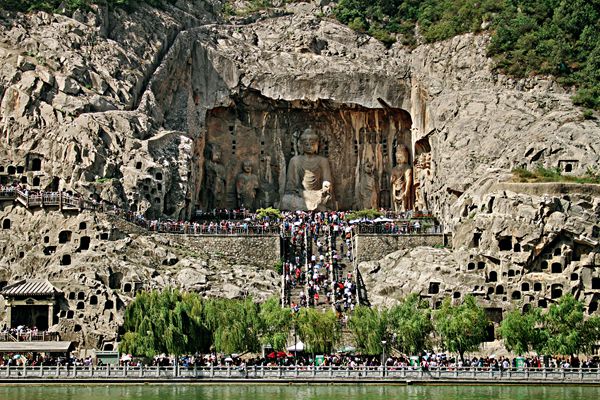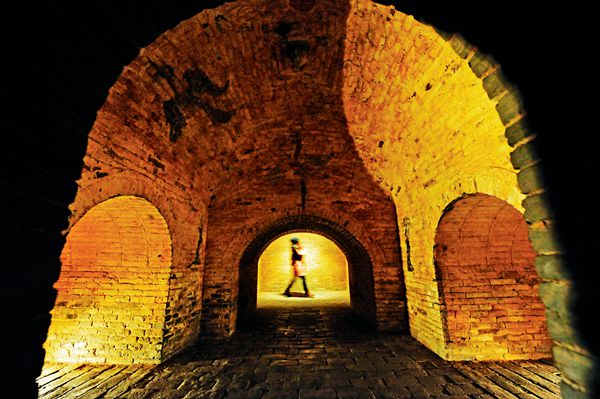For the Chinese nation, the Yellow River is more of a fountainhead than a river, and Luo-yang, a focal point along it, a birthplace of Chinese civilization. Many dynasties after the Xia Dynasty (c. 2070-1600 BC) established their capitals in Luoyang. Historical records also show that 100 or more emperors, including the most famous and sole woman ruler Wu Zetian (624-705), or Empress Wu of the Tang Dynasty (618-907), built imperial courts and established regimes there. Luoyang, along with Xi’an, Nanjing, and Beijing, was hence one of China’s four ancient capitals.

Luoyang’s Longmen Grottoes – one of the finest examples of Chinese carved stone Buddhist art – was listed as World Cultural Heritage in 2000.
Luoyang, once the political, economic, and cultural center of China where the Heluo Culture had developed, was regarded as the headstream of Chinese civilization. It was in Luoyang that China’s earliest historical documents, the Hetu and Luoshu, were unearthed.
In ancient times, Luoyang was the transportation hub of road networks extending in all directions. In the Eastern Han Dynasty (25-220), Luoyang was the starting point of the Silk Road leading to the eastern Mediterranean coast. Later it formed with the Grand Canal, cut in the Sui Dynasty (581-618), a 2,000-km-long north-to-south water transport network. Owing to its pleasant climate and four distinct seasons, Luoyang is world-renowned for its peonies and two world-class geological parks.
Mysterious Heluo Culture
“He” refers to the Yellow River, regarded as the mother of the Chinese civilization and headspring of Chinese culture, and “luo” to the Luoshui River. Heluo Culture originated in their confluence.
The semi-mythical Xia Dynasty, established in the 21st century BC, was the first hereditary dynasty in Chinese history. Its imperial palace and center of activities were situated around Luoyang. China’s earliest historical documents Hetu and Luoshu were buried and excavated here.
What was the original configuration of the Hetu and Luoshu? So many millennia having passed, there is no definite answer. Historical records and other surviving relics suggest that they were produced during Luoyang’s early period of human habitation. Chinese ancients incised images of natural phenomena on tortoise shells and animal bones and heated them to see how the materials cracked around these pictograms. This was the earliest form of divination in China. The traditional classic The Book of Changes evolved from these arcane practices here in Luoyang.

The six-meter-deep underground Luo-yang Ancient Tomb Museum, which houses 26 ancient tombs of different dynasties from the Western Han to the Song and Jin dynasties.
The Confucian classic The Book of Changes encapsulates the essential wisdom of Chinese ancients and is also the theoretical origin of natural philosophy and humanistic practices in China’s traditional cultures. The work has exerted profound impact on the nation’s politics, economy and culture throughout Chinese history. In early human society, Chinese ancestors, unequipped with scientific explanations for certain natural and social, as well as physiological phenomena, looked to the gods in their efforts to predict the future and so gain advantages and avoid harm. The Book of Changes was treated as a textbook that perfectly represented the will of the gods. It thus gradually transformed from a divination medium to a philosophy on the correct administration of state affairs to ensure national security. It also provided a model for appropriate human behavior and commendable characteristics.
In the late 1950s, archeologists discovered, 30 km east of Luoyang, the Erlitou Site that originated in 1750-1500 BC, a time parallel to that of the Xia Dynasty according to ancient records. They excavated everyday dwellings, palaces, potteries, copper-casting workshops, cellars, caverns and tombs. The site also contained large numbers of unearthed vessels and utensils, including stonewares, ceramics, jadeware, bronzeware, horn implements, and clamware. Among them was the three-legged, loop-handled bronze jue, the earliest known wine vessel. The Erlitou Site is believed to be the earliest imperial capital.
The Tang Dynasty and Buddhism
After the Xia Dynasty, 13 dynasties established their capitals in Luoyang. Among them the Tang Dynasty (618-907) was the most eminent and prosperous.
Chang’an (now Xi’an in northwestern China’s Shaanxi Province) was the original Tang Dynasty capital, but inconvenient transportation hampered its access to bountiful commodities. Luoyang was hence chosen as the accompanying capital, and later became the national economic center. The third Tang Dynasty emperor Li Zhi and his empress Wu Zetian, who later acceded to the throne, lived in Luoyang for many years. Empress Wu became ruler of China in 690, and moved the capital from Xi’an to Luoyang, changing its name to Shendu, or capital of the gods. Wu was the sole regnant empress in Chinese history.
During Empress Wu Zetian’s reign, she reformed the system of personnel selection to one where recruitment was based on ability rather than family connections, and paid close attention to agricultural production. She thus laid a solid foundation for the succeeding heyday. She at the same time embraced Buddhism and showed deep respect for eminent monks, treating them as mentors and presenting them with imperial gifts. All this dramatically heightened the social status of both Buddhism and Buddhist monks. During her rule she acted as a patron of Buddhist temples and carvings, and also spent a great deal on translating Buddhist sutras. Buddhism thus flourished in China.
Listed as the World Cultural Heritage, Luo-yang’s Longmen Grottoes, on a one-km-long stretch of cliffs, house 97,000 or more Buddhist statues. Among them the tallest stands 17.14 meters high and the smallest measures just two centimeters. The Longmen Grottoes, dug around the year 493, later went through more than 400 years’ large-scale construction. Built during Empress Wu’s rule, the grottoes account for two thirds of the total number of statues sculpted during the Tang Dynasty. Records show that Empress Wu made a personal donation of “20,000 strings of rouge and powder money” to complete the Vairocana Buddha, whose face was a likeness of her own.
The Vairocana Buddha is the tallest of all statues in the Longmen Grottoes. The head is four meters high, with a plump round face and crescent moon-shaped eyebrows above amiable, heavy-lidded eyes that observe the mortals at her feet. The Buddha’s enigmatic, subtle smile signifies inner peace and tranquility, and its robe patterned with concentric lines accentuates the head’s dignified ethos. This Buddha epitomizes the perfect combination of divinity and humanity.
Fragrant and Heavenly Peonies
Besides the Longmen Grottoes and White Horse Temple, peonies are a main aesthetic feature of Luoyang’s scenery. An ancient Chinese poem declares, “Peonies are the most beautiful flowers throughout the nation, and when in bloom their fragrance can astonish the faraway imperial palace.”
It is now customary among Luoyang locals to enjoy the splendor of peonies. When they are in blossom, the whole city teems with visitors, and when they wither, this frenzy recedes. Peonies stay in blossom from seven to 10 days, and the best time to enjoy this sight is in mid-April. Luoyang, well known for its advanced technology, has made studies of asexual propagation techniques of nurturing varieties of peonies, and promoted new strains. The city currently features 1,100-plus varieties of peonies in nine colors, including black, red, yellow, green, white, and purple. A total of 40 million plants or more grow there.
There are numerous places to enjoy the sight of peonies. Luoyang Peony Park, at the intersection of National Highway 310 and Airport Road, offers the brilliant sight of peonies in nine colors and 600 varieties. They include the Central Plains Peony and Northwest Rockii Tree Peony. Many have won awards, such as for the individual peony plant with the most flowers, of the weirdest shape, and that most popular with spectators. The diameter of the king peony can reach 29 centimeters.
Royal City Park takes its name from its location on the remains of the Eastern Zhou Dynasty (770-256 BC) and is now a world-famous relic park. It is also a main venue for visitors to enjoy the sight of more than 150,000 peonies in a 13-plus hectares area.
The National Beautiful Peonies Park is reputed as a Chinese peony gene bank. Far from the urban sprawl, peonies here blossom a little later, so providing an alternative to late-coming peony admirers. Famous for domesticating wild peonies and breeding new varieties, the park has become the country’s largest breeding and production base.
Peonies from China bloom throughout the world. From 724 to 749, Chinese peonies were brought to Japan where they were cultivated in 211 improved varieties. Japan now has the world’s largest number of cultivated peonies. China also introduced peonies to the United States in the late Qing Dynasty (1644-1911), and the American people have loved them ever since.
(Compiled by China Today)